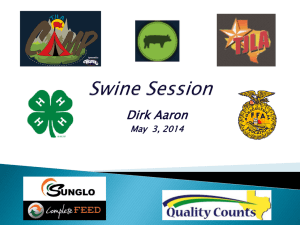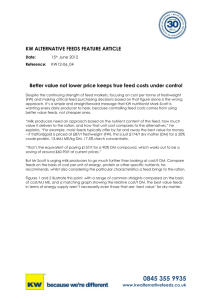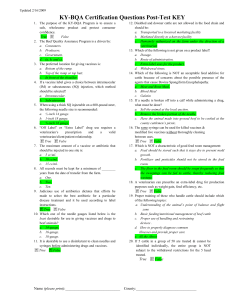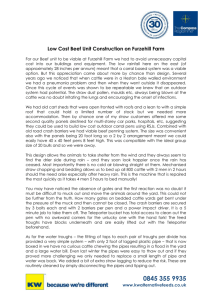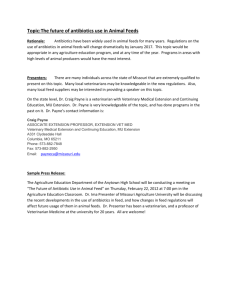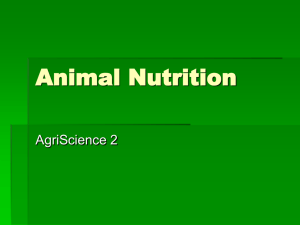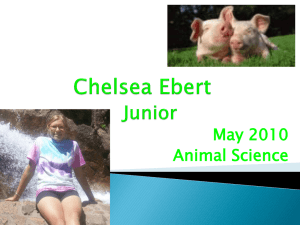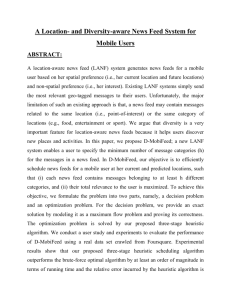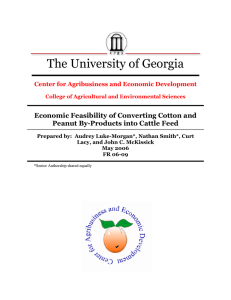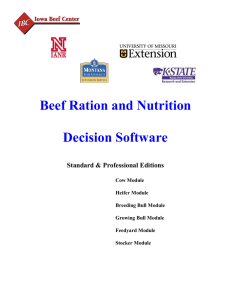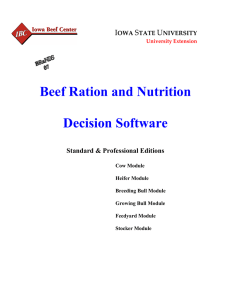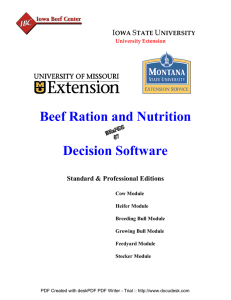Feeding Systems to maximise growth and drive down production costs
advertisement
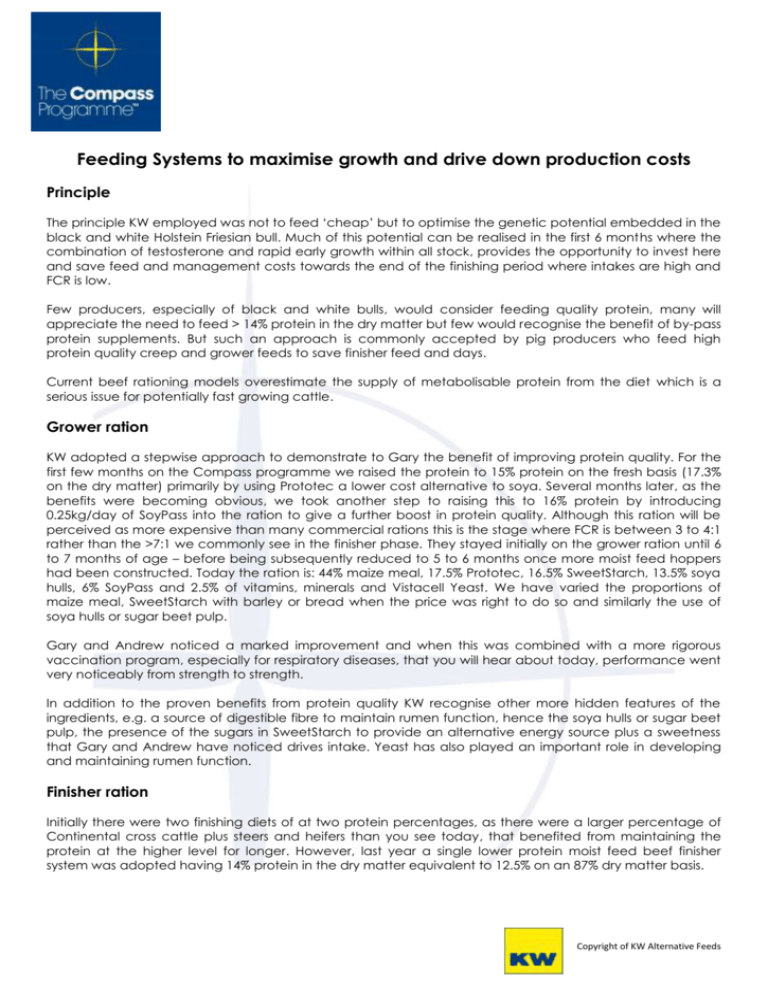
Feeding Systems to maximise growth and drive down production costs Principle The principle KW employed was not to feed ‘cheap’ but to optimise the genetic potential embedded in the black and white Holstein Friesian bull. Much of this potential can be realised in the first 6 months where the combination of testosterone and rapid early growth within all stock, provides the opportunity to invest here and save feed and management costs towards the end of the finishing period where intakes are high and FCR is low. Few producers, especially of black and white bulls, would consider feeding quality protein, many will appreciate the need to feed > 14% protein in the dry matter but few would recognise the benefit of by-pass protein supplements. But such an approach is commonly accepted by pig producers who feed high protein quality creep and grower feeds to save finisher feed and days. Current beef rationing models overestimate the supply of metabolisable protein from the diet which is a serious issue for potentially fast growing cattle. Grower ration KW adopted a stepwise approach to demonstrate to Gary the benefit of improving protein quality. For the first few months on the Compass programme we raised the protein to 15% protein on the fresh basis (17.3% on the dry matter) primarily by using Prototec a lower cost alternative to soya. Several months later, as the benefits were becoming obvious, we took another step to raising this to 16% protein by introducing 0.25kg/day of SoyPass into the ration to give a further boost in protein quality. Although this ration will be perceived as more expensive than many commercial rations this is the stage where FCR is between 3 to 4:1 rather than the >7:1 we commonly see in the finisher phase. They stayed initially on the grower ration until 6 to 7 months of age – before being subsequently reduced to 5 to 6 months once more moist feed hoppers had been constructed. Today the ration is: 44% maize meal, 17.5% Prototec, 16.5% SweetStarch, 13.5% soya hulls, 6% SoyPass and 2.5% of vitamins, minerals and Vistacell Yeast. We have varied the proportions of maize meal, SweetStarch with barley or bread when the price was right to do so and similarly the use of soya hulls or sugar beet pulp. Gary and Andrew noticed a marked improvement and when this was combined with a more rigorous vaccination program, especially for respiratory diseases, that you will hear about today, performance went very noticeably from strength to strength. In addition to the proven benefits from protein quality KW recognise other more hidden features of the ingredients, e.g. a source of digestible fibre to maintain rumen function, hence the soya hulls or sugar beet pulp, the presence of the sugars in SweetStarch to provide an alternative energy source plus a sweetness that Gary and Andrew have noticed drives intake. Yeast has also played an important role in developing and maintaining rumen function. Finisher ration Initially there were two finishing diets of at two protein percentages, as there were a larger percentage of Continental cross cattle plus steers and heifers than you see today, that benefited from maintaining the protein at the higher level for longer. However, last year a single lower protein moist feed beef finisher system was adopted having 14% protein in the dry matter equivalent to 12.5% on an 87% dry matter basis. Copyright of KW Alternative Feeds Currently we are taking advantage of two moist feeds ingredients, CTraffordgold and SupaStarch. Many of you will be familiar with Traffordgold a 50% dry matter, 21% protein and 13.4ME (MJ/kg dry matter) feed that has been trialled recently at Harper Adams (HAUC) (2009) and shown to be superior to a cereal based finishing system in terms of cost effective performance plus reduce the number of liver abscesses. SupaStarch is an opportunistic high starch potato based co-product that we use to replace a proportion of more expensive cereal starch sources. The mix also includes, SweetStarch to give a balance of energy sources e.g. sugar, soya hulls to help maintain rumen function in addition to that provided by the physical structure achieved by clean rape or wheat straw at ~ 7.5% of the dry matter. Performance Days to achieving target slaughter weight and allowing more cattle to pass through the system per annum is key to profitability on this farm. The results presented below are for the black and white bulls only as they represent ~ 80% of the cattle. They are presented using date of birth from 1 st January 2008 recognising that the Compass Programme did not start until May 2009. The black line is the line of best fit unless otherwise stated. They reflect the pattern shown by all cattle. They show: Significant reduction in ~ 210 days to slaughter post implementation of the Compass Programme to ~330 days Reduction in carcase weight of ~ 50kg to comply with the Buitelaar carcase specification. Significant cost of production improvement of up to £272 per head, based on: - Copyright of KW Alternative Feeds o o o o o o o o a reduced predicted liveweight at a 52% killing out percentage of 550 to 440kg using a midpoint liveweight of 490kg and a dry matter intake of 2.2% of body weight a dry matter intake of 10.8kg at £1.72/day for the current finisher ration fixed costs of £0.33 per head per day using recent HAUC figures for black and white bulls Selling price for black and white bulls for 0 minus carcases in this week’s Farmers Weekly of £2.75/kg deadweight (£1.72 + £0.33) * 210 days – 50kg * £2.75 = £272 per head An increase in daily carcase weight gain to 0.63 kg from < 0.5kg/day allowing for a ‘half’ calf birth weight of 20kg. Assuming a 52% killing out percentage this is an impressive > 1.2kg/day from birth to slaughter and above the current EBLEX targets. Carcase weight off the farm per month has increased ~ 40% year on year from a monthly average for June 09 to May 10 of 12276 tonnes to 17213 for the next 12 months. Future plans Driving down feed costs at the same nutrient specification will be a key driver in the future. The intention is to take advantage of the new feeds from the bio-ethanol plant Vivergo that will be commissioned early 2012. One of the feeds we are looking to utilise is the liquid distillery syrup. Early cost benefit analyses based on similar ENSUS derived material suggested a near 10% reduction in feed costs. In preparation for this Gary and his team will be modifying the freightliner container you may have seen as you entered the farm to hold 70 tonnes of liquid syrup which will allow him to take feed and opportunity loads. Let’s hope the side strengthening holds out! Following the success of the moist feed and the arrival of a new mixer wagon we will be introducing a moist feed earlier by producing an intermediate diet at the same specification as the dry grower feed. The completion of the cattle handling and weighing system will allow careful monitoring of the performance implications of diet and management change plus to be able to monitor critically the liveweight as the cattle approach the target liveweight. Driving down on losses, albeit currently at a low level, will also be an on going driver. As for expansion – see the tree line in the distance…………………………………... Copyright of KW Alternative Feeds

